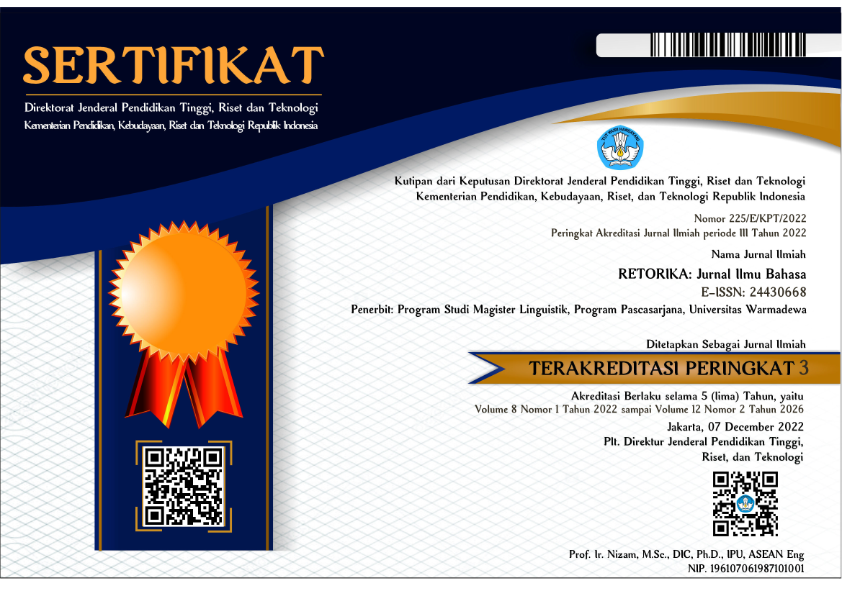Categories and Context of Taboo Words in Denpasar (How Words Are Classified as Taboo)
Abstract
Taboo expressions are part of a language that is produced by culture. Every language in an area certainly has taboo expressions, including Denpasar City. Denpasar City is an industrial center that attracts everyone from various regions to settle and survive. With the phenomenon of immigrants with various backgrounds, there is an intensity of multi-language. On the other hand, technological advances slowly change language norms, especially the use of taboo words. This study aims to examine taboo words and analyze the context of an utterance that becomes taboo. This study uses a qualitative approach. Data was obtained through field studies and literature. This study also employs the theory of ethnographic and anthropological linguistics approaches. The results show that taboo expressions in Denpasar are divided into four categories: language level of taboo, naming taboo, context-specific taboo words, and general taboo words. In addition to the context, an utterance that becomes taboo is not only influenced by the word but is the result of a combination of performance and participants in the process of its expression. Thus, an utterance becomes taboo or inseparable from several elements, namely what utterance is used, how the utterance is used, where the utterance is used, who is involved, and what is meant by the said utterance.
References
Adnyana, P. P. P. (2014). Pembelajaran Keterampilan Berbicara dalam Penggunaan. Linguistika: Buletin Ilmiah Program Magister Linguistik Universitas Udayana, 21, 1–9.
Allan, K., & Burridge, K. (2006). Forbidden Words: Taboo and the Censoring of Language. In Forbidden Words: Taboo and the Censoring of Language. https://doi.org/10.1017/9780511617881
Anom Kumbara, A. A. N., & Kartika Dewi, A. A. S. (2018). Migration in Denpasar City: Study of Adaptation Strategy and Its Implication of Social Culture and Environment. Udayana Journal of Social Sciences and Humanities (UJoSSH), 2(2), 81. https://doi.org/10.24843/ujossh.2018.v02.i02.p02
Barus, J. (2018). Tabu dalam Bahasa Karo. Universitas Sumatera Utara.
Barus, J., Sibarani, R., Saragih, A., & . M. (2018). Linguistic Taboos in Karonese Culture. KnE Social Sciences, 3(4), 411. https://doi.org/10.18502/kss.v3i4.1952
Creswell, J. W. (2013). Research Design: Qualitative, Quantitative, and Mixed Method Approaches (4th ed.). SAGE Publications, Inc.
Duranti, A. (1997). Linguistic Anthropology. In International Encyclopedia of the Social & Behavioral Sciences: Second Edition. Cambridge University Press. https://doi.org/10.1016/B978-0-08-097086-8.53060-8
Gao, C. (2013). A Sociolinguistic Study of English Taboo Language. Theory and Practice in Language Studies, 3(12), 2310–2314. https://doi.org/10.4304/tpls.3.12.2310-2314
Jay, T. (1992). Cursing in America: A Psychological Study of Dirty Language in the Courts, in the Movies, in the Schoolyards and on the Street. John Benjamin Publishing Co. https://doi.org/https://doi.org/10.1075/z.57
Kridalaksana, H. (2009). Pembentukan Kata dalam Bahasa Indonesia. Gramedia Pustaka Utama.
Kurniawati, L. (2019). Tuturan Umpatan (Nonoshiri No Kotoba) dalam Drama Great Teacher Onizuka ドラマ [グレートティーãƒãƒ£ãƒ¼ã‚ªãƒ‹ãƒ…ã‚«] ã«ãŠã‘る罵り言葉 [Universitas Diponegoro]. http://eprints.undip.ac.id/75717/
Lakoff, R. (1975). Language and Woman’s Place. Fitzhenry and Ehiteside Limites.
Laksana, I. K. D. (2009). Tabu Bahasa: Salah Satu Cara Memahami Kebudayaan Bali (Cetakan Pe). Udayana University Press.
Ljung, M. (2011). Swearing: A Cross Cultural Linguistic Study. In Palgrave Macmillan (First).
Mahayana, I. M. A., Suarjaya, A. A. G., & Putri, D. A. D. P. (2020). The Use of Taboo Words in Denpasar. International Journal of Psychosocial Rehabilitation, 24(8), 4623–4633. https://doi.org/10.37200/IJPR/V24I8/PR280479
Mahayana, I. M. A., Sukiani, N. K., Suwendri, N. M., & Winaya, M. D. (2019). Leksikon-leksikon Flora dalam Metafora Bahasa Bali: Kajian Ekolinguistik. KULTURISTIK: Jurnal Bahasa Dan Budaya, 3(2), 41. https://doi.org/10.22225/kulturistik.3.2.1192
Mahayana, I. M. A., Winaya, M. D., Suarjaya, A. A. G., & Saskara, I. G. S. H. (2022). Penggunaan Ungkapan Tabu di Desa Tenganan Pegringsingan: Kajian SosioPragmatik. Lingua, 19(2), 121–136. https://doi.org/10.30957/lingua.v19i2.763.orang
Mahayana, I. M., Suwendri, N. M., & Suarjaya, A. A. G. (2022). Context of Taboo Words in Tenganan Pegringsingan Village. Proceedings of the 1st Warmadewa International Conference on Science, Technology and Humanity, 302–312. https://doi.org/10.4108/eai.7-9-2021.2317758
Matiello, E. (2008). An Introduction to English Slang. In International Scientific Publisher (Vol. 2Matiello,). Polimetrica, International Scientific Publisher.
Moleong, L. J. (2006). Metodologi Penelitian Kualitatif. PT. Remaja Rosdakarya.
Robins, R. H. (2018). Language. Encyclopedia Britannica. https://www.britannica.com/topic/language
Spradley, J. P. (1979). Ethnographic Interview: An Occupational Therapy Needs Assessment Tool for American Indian and Alaska Native Alcoholics. In Occupational Therapy in Mental Health (Vol. 8, Issue 2). Hartcourt Brace Jovanovich, Inc. https://doi.org/10.1300/J004v08n02_05
Sugiyono. (2010). Metode Penelitian Kuantitatif Kualitatif dan R & D. Alfabeta.
Suweta, I. M. (2020). Sor Singgih Basa Bali dalam Kajian Intercultural Communication. Communicare, 1(1), 1–7.
Suwija, I. N. (2014). Tata Titi Mabaos Bali. Pelawa Sari.
Tabelak, D. (2018, April 23). Blunder “Nas Bedag,†Subanda: Tim Sukses Koster Harus Perbaiki Citra. Radar Bali.
Ullmann, S. (1977). Semantics: An Introduction to the Science of Meanings. Basil-Blackwell.
Wardaugh, R. (2006). An Introduction to Sociolinguistics Blackwell Textbooks in Linguistics. In Religion. Blackwell Publishing Ltd. https://doi.org/https://doi.org/10.1017/CBO9780511617881
Williams, J. P. (2008). Nonparticipant Observation. In L. M. Given (Ed.), Sage Encyclopedia of Qualitative Research Methods (Issue September, pp. 561–562). SAGE Publications Ltd. https://doi.org/10.4324/9781315266367-11
Yule, G. (2020). The Study of Language (Seventh Ed). Cambridge University Press.
Copyright (c) 2023 RETORIKA: Jurnal Ilmu Bahasa

This work is licensed under a Creative Commons Attribution-ShareAlike 4.0 International License.
This journal provides immediate open access to its content on the principle that making research freely available to the public supports a greater global exchange of knowledge.
All articles published Open Access will be immediately and permanently free for everyone to read and download. We are continuously working with our author communities to select the best choice of license options, currently being defined for this journal as follows: Creative Commons-Non Ceomercial-Attribution-ShareAlike (CC BY-NC-SA)
 Abstract viewed = 29 times
Abstract viewed = 29 times
 PDF downloaded = 32 times
PDF downloaded = 32 times

2.png)














